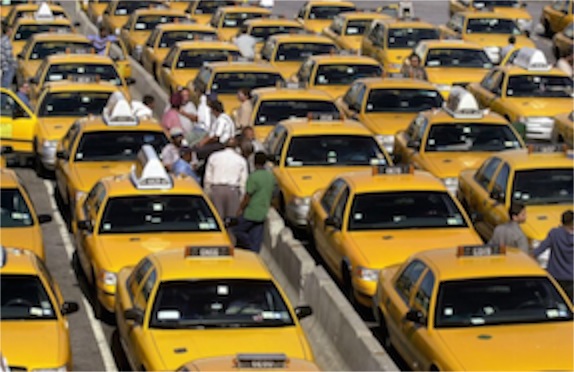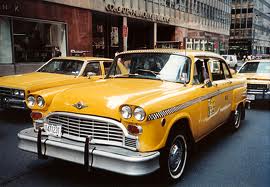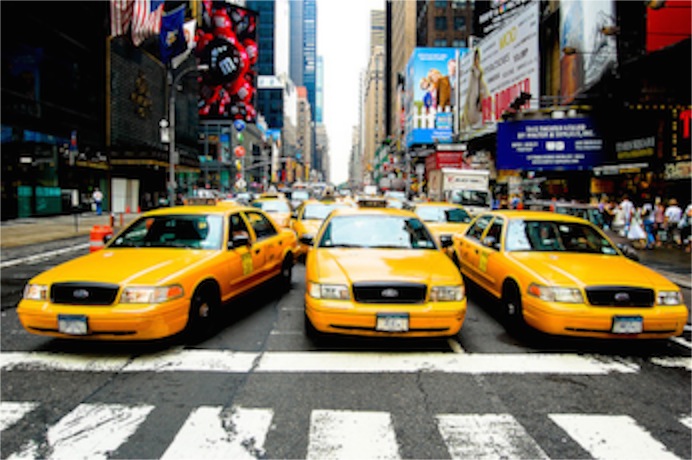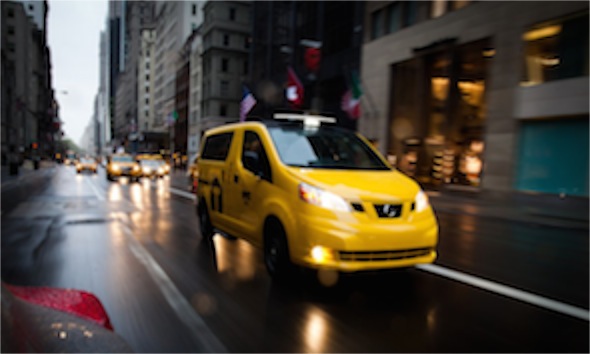New Cabs for New York
02/04/12 05:26
In 1969 my folks ordered a new Plymouth station wagon for factory delivery. The whole family flew to Detroit. After a few adventures in Detroit, we headed into Canada and came back into the US at Niagara Falls. From there we went to New York City, Washington, D.C. and back across the United States to Montana, including a stop at the Indianapolis Speedway and Chanute Air Force Base in Illinois. It was a grand vacation. I had a relatively new driver’s license and I shared in some of the driving, mostly in open, non-urban areas.
 One of the memories I have of that trip is of coming into downtown Manhattan in the afternoon. We were navigating with a map, but had little sense of where the traffic might be bad. We had a brand-new car with Montana license plates. It was a station wagon filled with kids and luggage and all sorts of things. And we drove into a sea of taxicabs. It sounds like a nightmare, but it wasn’t. The cab drivers knew that we didn’t fit in. They drove rudely and aggressively with one another, employing their horns regularly, changing lanes abruptly, crowding and cutting one another off. With us, however, they allowed extra space and treated us with suspicion as if we had no idea what we were doing, which was at least partially true. We went through Manhattan in this sea of yellow cabs with room to change lanes, and plenty of space all around our car. We didn’t even get close to getting a scratch on that new car.
One of the memories I have of that trip is of coming into downtown Manhattan in the afternoon. We were navigating with a map, but had little sense of where the traffic might be bad. We had a brand-new car with Montana license plates. It was a station wagon filled with kids and luggage and all sorts of things. And we drove into a sea of taxicabs. It sounds like a nightmare, but it wasn’t. The cab drivers knew that we didn’t fit in. They drove rudely and aggressively with one another, employing their horns regularly, changing lanes abruptly, crowding and cutting one another off. With us, however, they allowed extra space and treated us with suspicion as if we had no idea what we were doing, which was at least partially true. We went through Manhattan in this sea of yellow cabs with room to change lanes, and plenty of space all around our car. We didn’t even get close to getting a scratch on that new car.
 Back in those days, most of the New York cabs were Checkers. The boxy design was as iconic as the black Hackney carriages in London. At the time I was pretty aware of makes and models of cars. Auto designers were coming out with new shapes each year and there were features that made it easy to tell the differences. And I was a new driver, excited to learn about all of the different kinds of cars. Checker cabs, however, had no particular features to distinguish one year from another. They were designed for high mileage in heavy traffic situations and they were built to last for years of running through the potholes of New York City.
Back in those days, most of the New York cabs were Checkers. The boxy design was as iconic as the black Hackney carriages in London. At the time I was pretty aware of makes and models of cars. Auto designers were coming out with new shapes each year and there were features that made it easy to tell the differences. And I was a new driver, excited to learn about all of the different kinds of cars. Checker cabs, however, had no particular features to distinguish one year from another. They were designed for high mileage in heavy traffic situations and they were built to last for years of running through the potholes of New York City.
 It was several years before I got back to New York City. On my next visit, we took a cab from the airport to our hotel. The world had changed. Our cab was a Ford Crown Victoria with a vinyl interior. Who knows how many times that interior had been re-upholstered? There was a Plexiglas barrier between the front and rear seats and the driver was likely a recent immigrant to the US. At least it seemed that English wasn’t his first language. The trip from the hotel back to the airport is another story entirely, probably worth an entire blog. Suffice it to say that the driver told us he could beat the fares of any other driver. The meters were based on time elapsed, not mileage and this driver didn’t waste any time. We sped through streets and the tunnel at rates of speed that I wouldn’t have attempted. Fortunately we didn’t have to take time for a patrolman to write a ticket. And we did survive the ride. And the driver did get us there with a lower fare than we had paid getting to the hotel.
It was several years before I got back to New York City. On my next visit, we took a cab from the airport to our hotel. The world had changed. Our cab was a Ford Crown Victoria with a vinyl interior. Who knows how many times that interior had been re-upholstered? There was a Plexiglas barrier between the front and rear seats and the driver was likely a recent immigrant to the US. At least it seemed that English wasn’t his first language. The trip from the hotel back to the airport is another story entirely, probably worth an entire blog. Suffice it to say that the driver told us he could beat the fares of any other driver. The meters were based on time elapsed, not mileage and this driver didn’t waste any time. We sped through streets and the tunnel at rates of speed that I wouldn’t have attempted. Fortunately we didn’t have to take time for a patrolman to write a ticket. And we did survive the ride. And the driver did get us there with a lower fare than we had paid getting to the hotel.
New York is changing taxis once again. The winner of the competition to build the next generation of cabs for the city is Nissan, who secured a 10-year contract, worth an estimated $1 billion to be the sole manufacturer of New York taxis. There are about 13,000 of the vehicles. Starting next year, the Taxi and Limousine Commission will require licensed taxi operators in the city to purchase the Nissan NV 200. It is a min-van. There will be versions on display at the New York Auto Show next weekend.
It being New York, there have been disputes about nearly every element in the taxi design from the material used to make the divider between the driver and the passengers to the sound of the horn. Nissan hired a French design firm to assist with the choices of materials and colors for the cabs. Who would have though you needed a professional designer to choose the colors for a car that will be yellow on the outside and black on the inside? But this is New York City after all. Nissan isn’t accustomed to designing a particular vehicle for a single market, but a billion dollars worth of taxis is a significant amount. So the yellow is a bit brighter than the current fleet of taxis and there will be yellow stitching in the interior and yellow trim on the seat belt for a “unified” look. Antimicrobial material is being designed into the cabs to absorb odors. The floor mats are made from recycled tires.
 Of course Nissan believes that they are creating a new icon. They are hoping to replace the image of a New York taxi in the minds of all people. They may succeed. Times have changed. Those of us who remember watching Danny DeVito playing Louie De Palma on “Taxi,” are getting fewer and fewer with each passing year.
Of course Nissan believes that they are creating a new icon. They are hoping to replace the image of a New York taxi in the minds of all people. They may succeed. Times have changed. Those of us who remember watching Danny DeVito playing Louie De Palma on “Taxi,” are getting fewer and fewer with each passing year.
Nissan is planning to make the most of this week’s New York Auto Show. They will be announcing five new models in the next 15 months – new versions of the Altima, Pathfinder, Sentra, Versa and Rogue. Nissan North America plans to add $100 million to its ad budget to market those five new models. This is a company that spent $459.1 million on advertising in 2010. Nissan sales in the US accounted for 944,073 vehicles last year. If I’ve done my math correctly that means that $486 of the price of each car is the cost of advertising. I wish we had the option of paying $500 less and not having to watch the ads.
I don’t know when I’ll be in New York City next, but when I do make the trip I plan to pay attention to the floor mats and the interior partition in the cab. I may even see if I can get the driver to honk the horn to see just what sound the design team chose.
Silly me. I won’t have to ask in order to hear the horn.



New York is changing taxis once again. The winner of the competition to build the next generation of cabs for the city is Nissan, who secured a 10-year contract, worth an estimated $1 billion to be the sole manufacturer of New York taxis. There are about 13,000 of the vehicles. Starting next year, the Taxi and Limousine Commission will require licensed taxi operators in the city to purchase the Nissan NV 200. It is a min-van. There will be versions on display at the New York Auto Show next weekend.
It being New York, there have been disputes about nearly every element in the taxi design from the material used to make the divider between the driver and the passengers to the sound of the horn. Nissan hired a French design firm to assist with the choices of materials and colors for the cabs. Who would have though you needed a professional designer to choose the colors for a car that will be yellow on the outside and black on the inside? But this is New York City after all. Nissan isn’t accustomed to designing a particular vehicle for a single market, but a billion dollars worth of taxis is a significant amount. So the yellow is a bit brighter than the current fleet of taxis and there will be yellow stitching in the interior and yellow trim on the seat belt for a “unified” look. Antimicrobial material is being designed into the cabs to absorb odors. The floor mats are made from recycled tires.

Nissan is planning to make the most of this week’s New York Auto Show. They will be announcing five new models in the next 15 months – new versions of the Altima, Pathfinder, Sentra, Versa and Rogue. Nissan North America plans to add $100 million to its ad budget to market those five new models. This is a company that spent $459.1 million on advertising in 2010. Nissan sales in the US accounted for 944,073 vehicles last year. If I’ve done my math correctly that means that $486 of the price of each car is the cost of advertising. I wish we had the option of paying $500 less and not having to watch the ads.
I don’t know when I’ll be in New York City next, but when I do make the trip I plan to pay attention to the floor mats and the interior partition in the cab. I may even see if I can get the driver to honk the horn to see just what sound the design team chose.
Silly me. I won’t have to ask in order to hear the horn.